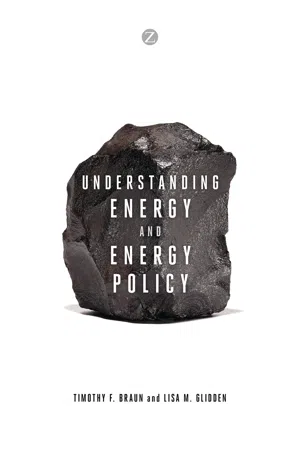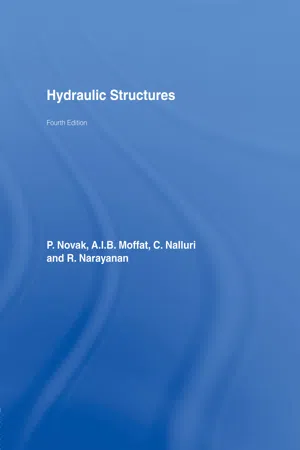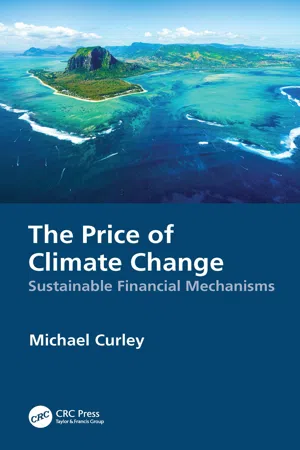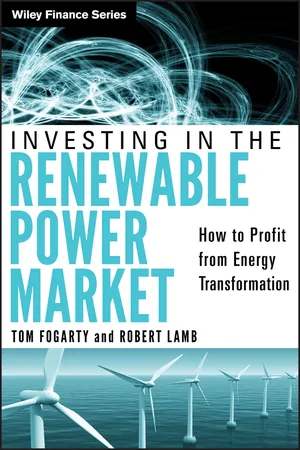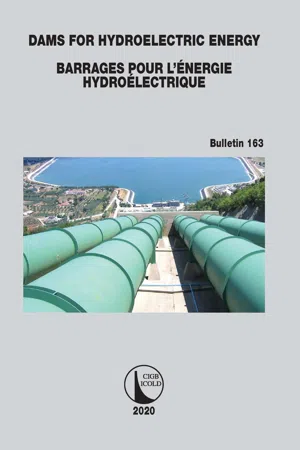Hydroelectric Power
Hydroelectric power is a form of renewable energy generated by harnessing the gravitational force of flowing or falling water. It involves the conversion of kinetic energy from water into electricity through turbines and generators. This method of power generation is considered environmentally friendly and sustainable, as it produces minimal greenhouse gas emissions and relies on the natural water cycle.
8 Key excerpts on "Hydroelectric Power"
- eBook - ePub
- Pedro Ponce, Arturo Molina, Omar Mata, Luis Ibarra, Brian MacCleery(Authors)
- 2017(Publication Date)
- CRC Press(Publisher)
...3 Hydroelectricity Generation of electricity based on water power is called hydroelectricity. Water potential or kinetic energy can be used to this purpose due to water height or flow, respectively [ 33 ]. About 99% of world energy is produced from primary sources, which are water, fossil fuel, and nuclear fuel [ 32, p. 53], making hydroelectricity paramount in overall energy usage. Hydroelectric generation can be broadly separated into conventional hydroelectric technologies and emerging hydrokinetic technologies; new techniques involve ocean tidal currents, wave energy, and thermal/salinity gradients in water, and represent a small but promising full-renewable energy source. On the other hand, conventional methods guarantee high energy production but have negative consequences on the ecosystem [ 57, p. 98]. As energy generation depends on the water cycle, numerous factors affect a Hydroelectric Power plant: rainfall intensity, the location’s topography, etc. [ 33, p. 177]. Water is also required for crops, cattle, human consumption, and ecosystem balance, so a power plant’s establishment and management imply a high-resources exhaustive-planning project. Besides those restrictions, hydroelectric plants have an average lifetime of 50 years, require no fuel, have low operation/maintenance costs, represent a negligible contribution to air pollution, and allow parallel operation, such as navigation, flood control, irrigation, etc. [ 33, p. 180]. Conventional hydroelectricity is one of the least expensive power plants; however, the change in environmental conditions have disabled many prime water sources [ 57, p. 98]. Hydroelectricity is considered to be renewable, as it depends on the everlasting water cycle; nonetheless, many variables must be taken into account since changes in water supply for a given location can decrease performance...
- eBook - ePub
- Timothy Braun, Lisa Glidden(Authors)
- 2014(Publication Date)
- Zed Books(Publisher)
...5 | HYDROPOWER Energy can be derived from moving water. Water power is hardly a new idea; it has been used for hundreds of years. Water power was the energy source for the beginnings of the Industrial Revolution; later on the switch was made to coal-powered steam engines as they were developed. As we discussed in Chapter 1, water can store potential energy when a dam holds it back. Releasing water from the dam so it flows downhill under the force of gravity makes it possible to extract energy from the moving water. This can be done with a simple water wheel or with a turbine to produce electric current. Power can also be generated from tidal and wave power. The majority of hydropower produced worldwide is from damming rivers. In this chapter we present two cases studies. The first is China’s Three Gorges Dam; the other is not a single-case study, but instead focuses on transnational issues stemming from large dam construction. Hydropower carries some extra political issues as rivers do not respect human boundaries and what happens upriver affects people and countries downriver. We list hydropower with other renewable sources of energy, but with some caveats. Most hydropower reservoirs are refilled by rivers and in that sense are renewable, but dams carry extensive impacts both on natural ecosystems and human populations that are akin to those of fossil fuels or nuclear power. Also, most reservoirs eventually fill up with sediment carried by the dammed-up river over a few decades to about a century. Once filled with sediment the hydropower station can still run using river flow directly, but most of the storage capacity is gone; this removes most of the power output flexibility of hydropower...
- eBook - ePub
- P. Novak, A.I.B. Moffat, C. Nalluri, R. Narayanan(Authors)
- 2017(Publication Date)
- CRC Press(Publisher)
...Chapter 12 Hydroelectric Power development 12.1 Introduction Hydropower is extracted from the natural potential of usable water resources, and about 20% of the world’s power requirement is at present derived in this way. Any water resources development of which a hydropower scheme may form part has environmental and social impacts, which must be taken into consideration at the initial planning stage. Also, legal and political implications must be carefully considered. One of the most important factors affecting any hydropower development is the cost of the scheme. With the rising costs and shortage of resources, economic comparisons with various energy sources – oil, coal, nuclear, gas and other renewable energy resources have to be made. In this, the fact that, unlike the ‘fuel’ costs of the hydropower plant, the costs of fuel for power generation by a conventional thermal plant rise at least with inflation makes hydroelectric plants economically advantageous, particularly in the long term. The latest technological advancements in Hydroelectric Power generation permit the selection of proper designs incorporating environmental and social requirements. Some innovations in the development of special turbine–generator units, such as bulb and slant-axis units, also suggest considerable reductions in construction costs, thus augmenting the benefits-costing of a project. Therefore, the selection of the final design requires the comparison of many alternative proposals from several sites, which may incorporate expansion facilities to meet future demands. Land use is one example of environmental considerations in hydropower development. Over 100kW/km 2 is exceptionally good, whereas 1 kW/km 2 is not efficient land use (Vladut, 1977). 12.2 Worldwide Hydroelectric Power development in perspective The total installed hydropower capacity worldwide is about 740 GW and the energy produced annually is about 2770TWh i.e...
- eBook - ePub
- Paul Breeze(Author)
- 2014(Publication Date)
- Newnes(Publisher)
...Many such schemes provide water for irrigation and drinking as well as power, and they can allow new industries to be established too. Economically hydropower is considered expensive to build but, when accounted for correctly, it can become one of the cheapest sources of electricity available. Since 2000, the introduction of large quantities of renewable generation from wind and solar power have also led to the recognition that hydropower has an important role to play in the balancing of intermittent renewable generation on grid systems. This is leading to a further reassessment of the role of hydropower. Pumped storage hydropower plants, which are large energy storage plants based on hydrotechnology, can be used to store energy from renewable plants for use when needed. However, conventional hydropower can provide significant grid support for other renewable generation too. Large hydropower projects—those over 30 MW is size—are not generally considered by regulatory authorities to be new renewable generation and in most regions do not attract support such as grants, special tariffs, or tax breaks. However, smaller hydropower schemes, which are generally classified as “small hydropower,” will often be included among the technologies that attract such support mechanisms. These smaller schemes are also less disruptive than their larger relatives and are consequently much easier to build. Hydropower resource The energy that is extracted from water by a hydropower plant and converted into electricity is potential energy contained within the mass of water as a consequence of its elevation. This energy is released as the water flows downhill, normally being dissipated in various ways within the watercourse down which it flows...
- eBook - ePub
The Price of Climate Change
Sustainable Financial Mechanisms
- Michael Curley(Author)
- 2021(Publication Date)
- CRC Press(Publisher)
...9 Locational Renewable Energy Sources DOI: 10.1201/9781003202639-9 By the phrase “locational renewable energy sources”, we are referring to hydroelectric, geothermal, and wind energy. Hydroelectric Power The human race has been using waterpower since at least the 4th century bce. Back in the Persian Empire, running water was captured by water wheels and was used for tasks such as grinding grain. A “grist mill” is a grain mill powered by falling water. It wasn’t until 1879 that the first hydroelectric generation station was built at Niagara Falls, New York. In present times, “Niagara Falls power” comes from several generating stations on both the American and Canadian sides of the Niagara River. In total the power plants on both sides produce 4.9 billion kilowatt hours of electricity, enough to light 3.8 million homes. The power plants on the U.S. side produce 2.7 billion kilowatt hours of electricity and the Canadian plants produce another 2.2 billion kilowatt hours. In general, there are two types of hydroelectricity generating facilities. The first is a “run-of-the-river” plant where the natural flow of a river, like the Niagara River, is harnessed to produce electricity. The second type is an impoundment. This is where river water is trapped by a dam and a reservoir is formed behind the dam. The water passing over, or through, the dam is used to generate the power. The Grand Coulee Dam is the largest hydroelectric facility in the United States. It is located in the Washington state on the Columbia River. Construction started in 1933 and the plant went operational in 1942. The Grand Coulee Dam produces 4.1 billion kilowatts of electricity, enough to light 4.2 million homes. One of the major reasons for the building of the Grand Coulee Dam was to produce the prodigious amounts of electricity necessary to manufacture aluminum, which was needed to build airplanes during the Second World War...
- eBook - ePub
- Volker Quaschning(Author)
- 2016(Publication Date)
- Routledge(Publisher)
...Because of its low specific power generation costs, hydropower potential has been largely tapped in Germany already. Large plants with capacities exceeding 100 MW are especially interesting financially. Hydropower is not uncontroversial, however, because of the negative impact resulting from the dramatic changes made to the natural world. In the future, the focus will therefore be on increasing the efficiency of existing hydropower plants through modernization and building micro-hydropower units. The latter have largely been overlooked up to now because of their greater specific cost. Outside Germany, new large hydropower plants continued to be built, however, such as the controversial Three Gorges Dam in China, which has a capacity of 18.2 GW. In general, a distinction is made between the following types of hydropower plants: run-of-river plants storage dams pumped-storage plants. Run-of-river plants Run-of-river plants (Figure 7.6) have a dam that backs up the flow of water to create a higher water level behind the dam than in front of it. The water is then directed through a turbine that drives an electric generator. A transformer then converts the generator’s voltage into grid voltage. The water’s power P w = ρ w · g · Q · H (7.1) is calculated from its density ρ W (ρ W ≈ 1,000 kg/m 3), useful height H (in m), gravitational acceleration g (g = 9.81 m/s 2) and discharge Q (in m³/s). Figure 7.6 Diagram of a run-of-river plant The useful height H can be determined with sufficient accuracy from the geodesic height difference of the water surfaces behind and in front of the dam. The power P W is therefore roughly proportional to the discharge Q. In contrast, the useful power decreases if the discharge is very great. If the discharge is above the rated discharge Q A, the turbines cannot handle all of the water themselves, so part of it has to be directed around the dam without being used to generate energy...
- eBook - ePub
Investing in the Renewable Power Market
How to Profit from Energy Transformation
- Tom Fogarty, Robert Lamb(Authors)
- 2012(Publication Date)
- Wiley(Publisher)
...However, they are expensive to construct and it can be difficult to obtain permits for new sites. But hydro power plants with damming can provide peaking power that, depending on transmission, can be combined with other renewable sources of energy. In Chapter 16, we discuss geothermal power plants. Notes 1. Stephanie Simon, “Water Surge Hydropower, Once Shunned Because of Environmental Concerns, Is Making a Comeback,” Wall Street Journal, September 13, 2010. 2. Simon, “Hydropower, Once Shunned.” 3. www.lipower.org/pdfs/company/projects/energyplan09/energyplan09-b.pdf. 4. Simon, “Hydropower, Once Shunned.” 5. Mark Griffith, “Conquering Time: Understanding the Value of Pumped Storage,” Public Utilities Fortnightly, October 28, 2008. 6. Griffith, “Conquering Time.”...
- CIGB ICOLD(Author)
- 2020(Publication Date)
- CRC Press(Publisher)
...Regardless of stellar efforts and significant projects that are in progress for the development of new hydro capacity, only about 20% of hydropower potential has been developed in Asia. In Africa, where 65% of the population do not have access to electricity and the needs are consequently very urgent, only a very small amount of the hydroelectric potential has been harnessed. In the last decade, after a period of serious difficulties and disputes, several important declarations have been adopted in favour of hydropower: At the World Water Forum in Kyoto 2003, the most substantial effort to address the global warming problem, the Declaration of 170 Countries stated: ‘” We recognise the role of hydropower as one of the renewable and clean energy sources, and that its potential should be realised in an environmentally sustainable and socially equitable manner”’. The 2004 Political Declaration adopted at the International Conference for Renewable Energies acknowledged that renewable energies, including hydropower, combined with enhanced energy efficiency, can contribute to sustainable development, providing access to energy and mitigating greenhouse gas emission. At the 2004 United Nations Symposium on “Hydropower and Sustainable Development”, the representatives of national and local governments, utilities, United Nations agencies, financial institutions, international organizations, non-government organizations, scientific community, international industry associations, made a strong Declaration in support of hydropower...

